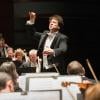
Music Director Donato Cabrera led the California Symphony in an audacious concert at the Lesher Center in Walnut Creek on Saturday, March 25. The program literally centered around Gustav Mahler in that it consisted of music by three composers closely associated with the man but nothing by Mahler himself. We know his music by now; it’s time to hear something of the context in which he worked. So, the three composers were Mahler’s wife, Alma; his colleague and sometime rival for Alma’s hand, Alexander Zemlinsky; and his close friend and fellow conservatory student, Hans Rott.
Though Alma Mahler’s Five Songs received the most exquisite performance, the sheer magnitude of Rott’s Symphony No. 1 in E Major gives it pride of place. This virtually unknown composer completed his ambitious and intriguing, if wayward and immature, First Symphony in 1880 at the age of 21 and promised to be one of the major composers of his time. But he developed a debilitating mental illness and then died at the age of 25.

What Rott could have accomplished had he kept his health and life is hard to imagine. Perhaps he would have become Gustav Mahler, for his symphony is a close template for Mahler’s own First Symphony of some eight years later. That was probably Mahler’s intent, for he honored Rott as the initiator of the kind of symphony that he, the younger composer, wanted to write.
Rott’s epic hour-long journey begins with a quiet theme for solo trumpet and concludes with the same theme in full force from the massed brass and winds. Mahler’s First Symphony, slightly shorter, also brings back material from the first movement in its finale. Both symphonies begin with three large movements that are nevertheless almost rendered as preludes compared to their massive, multipart finales. As with Mahler’s finale, there’s a passage about halfway through Rott’s that could serve as a coda, and possibly should have.
Much of the writing sounds a lot like Mahler, too. Cabrera played up the similarities, emphasizing in particular the unmistakable resemblance between the two symphonies’ lively scherzos. At times, as in a cheeky fugato, Rott sounds more like Mahler than Mahler does. Rott also owes much to Anton Bruckner, with whom he studied. But Cabrera did not emphasize the Brucknerian sound in the music, nor did he place any weight on the symphony’s most infamous moment, a heavy theme in the finale that Rott has been accused of lifting wholesale from the finale of Brahms’s First Symphony of four years earlier.
Rott didn’t plagiarize Brahms’s famous theme; the two are of a kind, but Rott’s is not a copy. What Rott did steal was Brahms’s orchestration. Little else in the symphony sounds like Brahms, though, which points to a somewhat erratic quality in the composition. The inexperienced composer often has a few brass instruments playing quietly while expecting them to be heard over a background of churning or shimmering strings. It’s difficult to keep the balance here, and Cabrera and the orchestra did not always succeed. But they were exemplary in navigating Rott’s hushed and expectant stretches of quietude and his frequent abrupt transitions around full tutti sections. This is an attractive work, and the California Symphony gave a vivid and dedicated performance.

Alma Mahler’s contribution to the program was a cycle of five songs to texts by various poets, edited by Gustav and issued by his publisher in 1911. These were written to be accompanied by piano but were presented here in a light and sprightly orchestration by Jorma Panula. The singer was the powerfully voiced and vividly expressive contralto Sara Couden, who brings extra intensity to any assignment she undertakes. She gave each of these songs, from the emotionally yearning “Laue Sommernacht” (Warm summer’s night) to the coy and coquettish “Bei dir ist es traut” (With you, it is comfortable), a character of its own. They have a more direct and folkish air than Gustav’s songs, particularly “In meines Vaters Garten” (In my father’s garden), which is emphatically strophic in verse if less so melodically.
Zemlinsky’s offering was his Lustspiel Overture. Not as comic as the title might suggest, nor as memorable as a listener might hope, it’s a genial and relaxed work that shares the thick, interwoven scoring of Zemlinsky’s longer and more serious pieces but differs from them in its chipper melodies and lighter tone. Dating from the 1890s, it’s not entirely premonitory in sounding a bit like Richard Strauss in its more dramatic passages. It carries something of the tone of a Brahms intermezzo in its calmer moments.
The orchestra’s musicians were unutterably gallant in carrying off this entirely unfamiliar program of somewhat sketchy music. Of the three, Alma Mahler was clearly the best composer, though none of them are as tiresome as Gustav at his most self-indulgent. The audience willing to come out and hear this strange concert also deserves praise. This was a thoroughly informative and enlightening evening.




